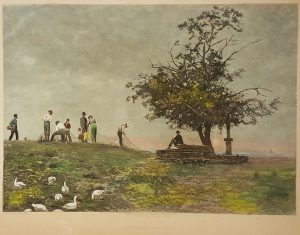(Click to Enlarge)
Hand Colored Photogravure on Paper
7 3/4 x 10 3/4 inches
10 5/8 x 15 1/4 inches complete
Titled Mending the Net, Gloucester on the Delaware
After Eakin’s 1881 painting
Thomas Eakins printed lower left
Center reads Copyrighted 1885 by Photogravure Co Phil, Carson Stewart & Co 1887.
En verso in pencil it reads “Painted by Thomas Eakins born at Philadelphia 1844 One of his best-known portraits?…of the ??inton, of this ???”
Good condition with loss and tears on far edges
Thomas Eakins (1844–1916), America’s greatest, most uncompromising realist, dedicated his career to depicting the human figure—in oil and watercolor, sculpture and photography. Eakins was born in Philadelphia in 1844. He was enrolled at the Pennsylvania Academy of the Fine Arts from 1862 to 1866, attended anatomy lectures at Jefferson Medical College, and profited from contact with Philadelphia’s art collections, exhibitions, and artists. Arriving in Paris for study in 1866, Eakins was in the vanguard of young painters who would shift the focus of American art from landscape to the figural subjects favored by the European academies. After almost three years of instruction in France, principally at the École des Beaux-Arts under Jean-Léon Gérôme (1824–1904) and briefly with the portraitist Léon Bonnat (1833–1922), and a winter working in Spain, Eakins returned to Philadelphia in July 1870. From boyhood, he had himself been athletic; as an ambitious, original young artist intent on portraying the world around him, he embraced as subjects the activities that he himself enjoyed, which provided opportunities to demonstrate his technical skill.
While Eakins was painting works that expressed his admiration of athletes and outdoor activities, he was also creating intense, brooding images of women and children in quiet, shadowed interiors. These canvases, usually of friends and family, straddle the divide between genre and portraiture. In late March 1875, the artist wrote to a friend, “I feel to myself that I am going soon to do work so much better than anything that I have made yet.” It seems likely that the project sparking Eakins’ enthusiasm was the canvas that occupied him for almost a year—The Gross Clinic (1875; Jefferson Medical College, Thomas Jefferson University, Philadelphia)—and that provoked much controversy at the Philadelphia Centennial Exhibition.
Having begun teaching at the Pennsylvania Academy in 1876, he transformed it into the leading art school in America. However, discontent also arose concerning his teaching methods, especially his emphasis on the nude. Eakins’ own easy acceptance of nudity as an essential element of academic study did not please Victorian Philadelphia. In January 1886, lecturing about the pelvis to a class that included female students, Eakins removed a loincloth from a male model so that he could trace the course of a muscle. Angry protests by parents and students forced him to resign at the request of the Academy board.
From 1887 until the end of his career, Eakins focused almost exclusively on portraiture. He usually worked at life scale, renouncing outdoor light and focusing on the sitter in isolation. His portraits reflect an investigative candor that is distant from the glamour or artiness in the paintings of his peers James McNeill Whistler and John Singer Sargent. Eakins rarely received commissions for portraits and most of his sitters were friends or acquaintances. In 1898 and 1899, for the first time since the 1870s, Eakins returned to the subject of athletics. His boxing and wrestling pictures are as revolutionary in their subject matter as his earlier rowing scenes. Although few critical voices actively promoted Eakins’ vision, the sheer steadiness of his quest to center his art on the accurate portrayal of the human figure had won him a position in the art world.
Eakins died on June 25, 1916. In November 1917, The Metropolitan Museum of Art opened a memorial exhibition of sixty of his paintings. The Pennsylvania Academy followed a month later with an exhibition of 139 works. By the early 1930s, Eakins was considered one of America’s greatest artists, the reputation he enjoys today.
H. Barbara Weinberg
The American Wing, The Metropolitan Museum of Art
Philadelphia Museum of Art:
Over the landscape he had painted on his canvas, Eakins projected his selected photographic studies, one-by-one, to mark the positions and salient details of each figure or element of the composition. Oil sketches made on-site served as notes to indicate the original colors of every component. Toning glazes consolidated the whole into a thoroughly convincing scene of the awakening respect two children experienced before the quiet devotion of fishermen practicing their craft.




